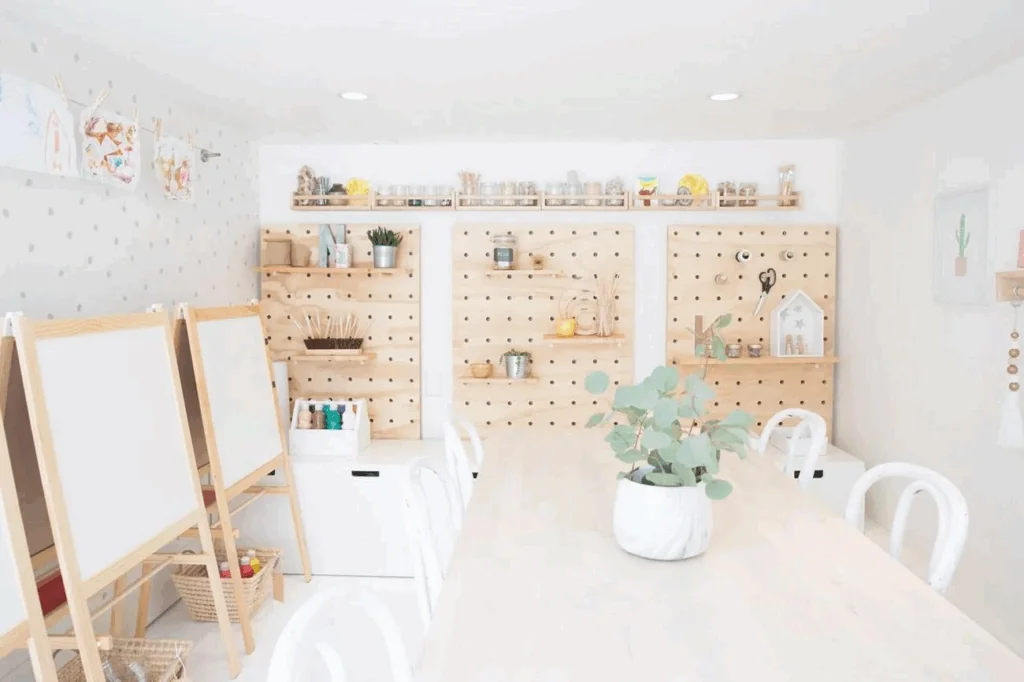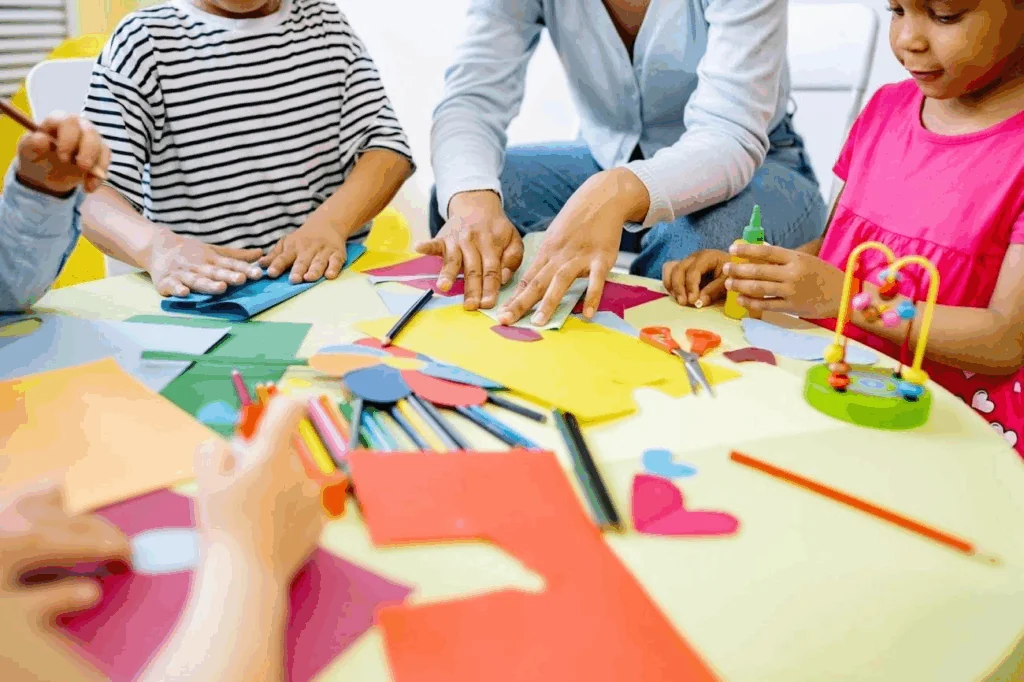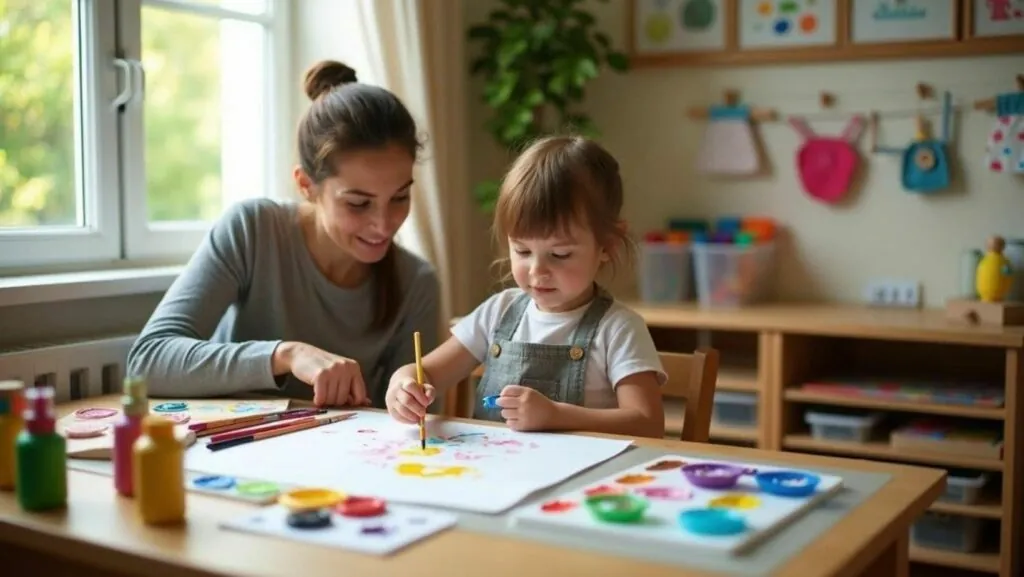Table of Contents
ToggleArt education goes beyond teaching kids to draw or paint. The right guidance helps children develop essential skills like self-expression, problem-solving, and resilience when facing challenges. Parents can see how creativity blossoms with proper support.
Most parents find it challenging to begin or discuss art with their children. Kids shouldn’t feel pressured to perform for reactions through empty praise. They need to focus on their personal thoughts about their creations. On top of that, it works best when parents demonstrate artistic activities themselves to inspire their children’s creativity.
This piece explores easy ways to support your child’s creative experience. You’ll discover practical steps to make art an enriching part of your family’s daily life – from creating an art space at home to having meaningful conversations about their artwork. These approaches can help nurture your child’s creative growth, regardless of your artistic background or comfort with a paintbrush.
Why Art Matters for Kids
Art does much more than help children create pretty pictures. Research shows children who participate in artistic activities perform better academically and solve problems better than those who don’t. Let me explain why art plays such a vital role in our children’s growth.
Emotional and cognitive benefits
The first few years open a critical window for brain development. Children form more than one million neural connections every second. Art switches these connections on when children use multiple senses at once – they squish clay and mix colors.
Creative activities also bring remarkable emotional benefits. Studies reveal that artistic expression helps children:
- Process complex emotions they can’t put into words yet
- Build resilience and self-confidence
- Feel less stressed and anxious
A study in Educational Researcher shows that children who visit museums and cultural institutions develop better cultural tolerance, historical empathy, memory, and critical thinking skills.
How creativity supports problem-solving
The creative process presents children with many challenges. They must choose colors, plan their design, and bring their ideas to life. These experiences naturally encourage critical thinking as children review their options and find solutions.
Knowing how to imagine multiple solutions to one problem (divergent thinking) is a vital skill that art develops. Research by George Land and Beth Jarman revealed something remarkable – 98% of 3-5 year old children scored at “genius level” in creativity tests. This number dropped to just 2% in adulthood. Their findings highlight why we need to keep creative thinking alive through art.
Art as a tool for self-expression
Art gives children a powerful way to communicate. Young minds might not have the words to express complex feelings, but they can share through color, movement, and texture.
“The language of visual art—colors, shapes, lines, and images—speak to us in ways that words cannot,” explains Cathy Malchiodi in her book, The Art Therapy Source Book. This non-verbal expression becomes valuable during tough times. It serves as an emotional outlet where children can safely explore and understand their feelings.
Art helps children find their unique identity and voice. This sense of agency contributes by a lot to their social and emotional growth.
Setting Up a Creative Environment at Home

A dedicated space for art exploration at home builds the foundation for your child’s creative trip. Studies show kids are more likely to take part in creative activities when they get frequent chances to express themselves artistically throughout the day. Here’s how you can create an environment that nurtures creativity and independence.
Create a dedicated art space
You don’t need a picture-perfect studio or huge room to encourage creativity. A corner of your dining room, living room, or kitchen can transform into a vibrant art space. Choose an area with good natural light and floors that are easy to clean. Setting up the art space in a common area shows your kids that art deserves priority in your home.
Including a few pieces of inspiring artwork, such as modern abstract prints from Art by Maudsch, can expose children to different styles and spark curiosity about what art can be.
Keep supplies visible and available
Kids use art materials more often when they can see them. This availability helps build confidence and lets them create art on their own. Clear containers work best so children spot what they need without searching through everything.
These storage solutions work well:
- Rolling carts with open compartments
- Clear jars for markers, pencils, and crayons
- Low shelves your child can reach
- Portable caddies that move around the house
“By having supplies out in the open, we encourage autonomy in art making and help to build our kids’ confidence as artists,” says one art educator. New materials can keep the space exciting when rotated regularly.
Encourage mess and experimentation
Children learn through experimentation, so they need chances to create freely—not just during planned art times. This means accepting some mess along the way.
Try these mess management tips without limiting creativity:
- Use washable art supplies for younger children
- Get smocks or art aprons
- Put a drop cloth or plastic sheet under the art area
- Keep wet wipes handy for quick clean-ups
Note that young children care more about creating than what they produce. Don’t direct their artwork or ask “What is it?” Watch their process and ask open questions about their choices instead.
Fun and Simple Art Activities to Try

Want to dive into some fun art projects? These simple activities need just a few supplies but pack tons of creative possibilities for kids starting their artistic adventure.
Paper plate masks and storytelling
Paper plates can become magical masks with a handful of supplies. Cut eye holes in a plate, add paint, and let your child decorate it with construction paper, feathers, or pom-poms. These masks help kids create characters and stories around their artistic creations.
Salt dough sculptures
A mix of one part salt, one part water, and two parts flour creates this versatile modeling material. Kids can roll “snakes” for rainbow sculptures or press shells into the dough for imprints. The creations can be air-dried or baked at 180°C until hard, then painted and kept as keepsakes or gifts.
Watercolor resist painting
This magical technique reveals hidden designs as watercolors interact with wax or oil. Draw with white crayons or oil pastels on watercolor paper, then wash over with liquid watercolors to see your secret design appear. You can also try glue resist or rubbing alcohol to create different effects.
Recycled material sculptures
Your recycling bin can be an art supply goldmine! Cardboard tubes make perfect robots, milk cartons become sailboats, and paper bags turn into flower crowns. Kids learn about environmental care while their creativity soars as they see new possibilities in everyday objects.
Guided painting for building confidence
Structured painting activities help kids express their thoughts and emotions on canvas. Instead of directing every stroke, gentle guidance through observational comments works better. One helpful option for beginners is using paint by number for kids kits, which provide a clear structure while still allowing children to explore color and technique. Kids build confidence as they play with colors, textures, and techniques to create meaningful art.
How to Talk About Art with Your Child
Our conversations about art with children impact their creative confidence deeply. Parents often struggle to find the right words at the time their child shows them a scribble or painting.
Avoid empty praise
Simple compliments like “beautiful!” or “good job!” can actually limit creativity over time, even though they seem supportive. Kids might start creating art just to receive praise rather than enjoying the creative process. This type of validation teaches them to depend on others’ opinions instead of developing their own artistic judgment.
Use observational comments
Specific descriptions work better than vague compliments. You can say “You used lots of blue in this corner” or “Those zigzag lines look very energetic.” These detailed observations show your child that you take time to look at their work carefully.
Ask open-ended questions
Questions that spark discussion help children think deeper: “What inspired you to make this?” or “How did you create that interesting texture?” Unlike asking “What is it?”—which sounds judgmental—these questions start conversations naturally.
Let them explain their work
The most effective response is simple: “Tell me about your artwork.” This approach lets your child take the lead and shows that their perspective matters most. It demonstrates that you value their creative expression without forcing your own interpretation.
Conclusion
Introducing kids to art isn’t about talent. It’s about giving them space to explore, imagine, and express themselves. Through simple creative activities, children build confidence, emotional resilience, and problem-solving skills.
Art gives children more than just something to display. It helps them understand themselves and their world. Your support is what makes that possible.

